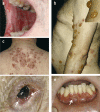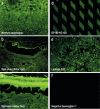Bullous Autoimmune Dermatoses–Clinical Features, Diagnostic Evaluation, and Treatment Options
- PMID: 34369370
- PMCID: PMC8380840
- DOI: 10.3238/arztebl.m2021.0136
Bullous Autoimmune Dermatoses–Clinical Features, Diagnostic Evaluation, and Treatment Options
Abstract
Background: Bullous autoimmune dermatoses are a clinically and immunopatho - logically heterogeneous group of diseases, characterized clinically by blisters or erosions of the skin and/or mucous membranes. In Germany, their prevalence is approximately 40 000 cases nationwide, and their incidence approximately 20 new cases per million people per year.
Methods: This review is based on publications that were retrieved by a selective search of the literature focusing on the current German and European guidelines.
Results: Recent years have seen the publication of guidelines, controlled prospective clinical trials, and multicenter diagnostic studies improving both diagnosis and therapy. Specific monovalent and multivariate serological test systems and pattern analysis of tissue-bound autoantibodies allow identification of the target antigens in 80-90% of patients. This enables the precise classification of disease entities, with implications for treatment selection and disease outcome. In 2019, the anti-CD20 antibody rituximab was approved by the European Medicines Agency for the treatment of moderate and severe pemphigus vulgaris, with an ensuing marked improvement in the care of the affected patients. To treat mild and moderate bullous pemphigoid, topical clobetasol proprionate is recommended, in severe disease, combined with systemic treatment, i.e. usually (a) prednisolone p.o. at an initial dose of 0.5mg/kg/d , (b) an immunomodulant, e.g. dapsone or doxycycline, or (c) prednisolone plus an immunomodulant.
Conclusion: The early recognition and precise diagnostic evaluation of bullous autoimmune dermatoses now enables improved, often interdisciplinary treatment, in accordance with the available guidelines. Current research projects are focused on new treatment approaches, an improved understanding of the underlying pathophysiology, and further refinements of diagnostic techniques.
Figures




References
Publication types
MeSH terms
LinkOut - more resources
Full Text Sources
Medical
